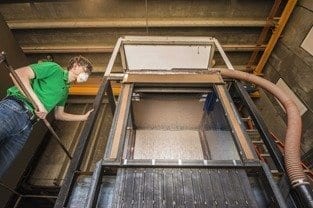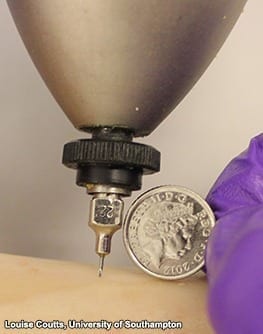
New research from the Niels Bohr Institute shows that cement made with waste ash from sugar production is stronger than ordinary cement.
The research shows that the ash helps to bind water in the cement so that it is stronger, can withstand higher pressure and crumbles less. At the same time, energy is saved and pollution from cement production is reduced.
Cement is comprised of chalk and clay, which are mixed together and heated at high temperatures in a cement kiln. The mixture is then crushed into a powder. When the cement powder is mixed with water a chemical process takes place, which causes the cement mixture to harden. Cement is used as a building material throughout the world.
In some countries where sugar cane is grown, agricultural waste product from sugar production has been added to the cement mixture for many years. Once the sugar has been extracted from the sugar can you are left with a lot of fibre waste, which is used as fuel for energy production. From the energy production you get a lot of ash, which needs to be disposed of. In some countries, like Cuba and Brazil, the ash is added into cement mixtures.
“I have been studying cement using quasi-elastic neutron scattering for several years and researchers from Brazil asked whether I wanted to analyse samples of cement mixed with waste products in the form of sugar cane ash. I decided to say yes to the project, which aimed to investigate the properties on a nano-scale and map the mobility of water in the cement. The quality and strength of cement is directly related to how much of the water is chemically bonded. The more the water can move around, the worse it is for the strength and durability,” explains Heloisa Bordallo, who does research in nanophysics at the Niels Bohr Institute at the University of Copenhagen.
Neutron scattering reveals water
Heloisa Bordallo was sent a number of cement samples from Brazil. The samples contained varying amounts of ash from sugar can production. Their innermost dynamics were then examined. This took place at the ISIS facility in the UK. The samples were placed in an instrument where they were bombarded by neutrons.
“Using neutron scattering, we can see how the water inside the sample moves. Neutrons are shot into the sample and when neutrons hit the water’s hydrogen atoms, they interact and the neutrons scatter and are picked up by the detectors. We repeat this for several hours and by analysing the data we can determine how the water inside the sample is moving and also determine its local environment,” explains Johan Jacobsen, who performed the experiments as part of his thesis for the graduate programme in physics at the Niels Bohr Institute.
The experiments showed that the cement mixed with approx. 20 percent ash had good properties. The water the cement pores was bound to the ash and moved around less. This explains why the ash cement is stronger, can withstand higher pressure and will crumble less.
Potential for environmentally friendly ash cement
Cement typically takes a week to solidify. After one month, 70 percent of the process has been completed, but the process continues for many years. Ordinary cement is generally stronger during the first few months than the ash cement, but after a year the ash cement is stronger than the ordinary cement.
The Latest Bing News on:
Environmentally friendly cement
- Rising Construction Activities Propel Global Concrete Admixture Demand, Anticipated to Reach US$ 27.4 Billion by 2032on April 26, 2024 at 7:59 am
The global concrete admixture market is expected to reach a value of US$ 15.1 Billion in 2022. With a steady CAGR of 6.1%, the market will reach US$ 27.4 Billion by 2032. A notable rise in the use of ...
- Navrattan Group to launch 'Green cement' in India soonon April 26, 2024 at 4:21 am
This product promises to be a game-changer, addressing the growing demand for sustainable building materials while not compromising on performance or durability.
- Reducing embodied carbon in concrete constructionon April 25, 2024 at 12:15 am
Mixing water-repelling pore blockers with concrete helps minimize a project’s carbon footprint while maximizing the lifetime of new construction.
- SCG pushes for continuous sustainability thru green innovation, eco-friendly productson April 23, 2024 at 9:33 pm
Siam Cement Group (SCG), a pioneer in the construction material industry and the number one brand in Thailand, showcased during the 2024 Construction Exhibit (CONEX) some of its ground-breaking ...
- Cement Tiles Market To Reach USD 40.2 Billion By 2032 | DataHorizzon Researchon April 23, 2024 at 1:00 am
The cement tiles market size was valued at USD 22.9 Billion in 2023 and is expected to reach a market size of USD 40.2 Billion by 2032 at a CAGR of 6.4%.Fort Collins, Colorado, April 23, 2024 (GLOBE ...
- Cob Houses, Rammed Earth, and Hemp Mixtures: These Eco-Friendly Building Materials Start in the Soilon April 22, 2024 at 5:00 am
Firms that specialize in construction with sustainable materials shed some light on the misconceptions around their work (no, it’s not going to just wash away in the rain) ...
- Green getaways: Eco-friendly hotels and resorts around the worldon April 19, 2024 at 10:30 pm
In a world where sustainability is increasingly becoming a top priority, these eco-friendly hotels and resorts are leading the charge towards a greener future. From lush tropical paradises to mountain ...
- Construction industry in need of green cementon April 18, 2024 at 5:00 pm
KUALA LUMPUR: The construction industry is in dire need of eco-friendly cement, also known as “green cement,” to realise the nation’s aspiration to achieve net-zero greenhouse gas emissions ...
- New cement carrier being built for Great Lakes shipping routeson April 18, 2024 at 11:37 am
A new eco-friendly cement carrier for the Great Lakes is being built in the Netherlands, GCaptain.com reports. Eureka Shipping expects delivery of the vessel in 2025, the report said. It will replace ...
- Max Group begins production of eco-friendly, cost-effective concrete blockon April 18, 2024 at 8:38 am
Max Group, one of the largest construction companies in Bangladesh, has entered into commercial production of autoclaved aerated concrete (AAC) blocks and panels as it formally inaugurated its new ...
The Latest Google Headlines on:
Environmentally friendly cement
[google_news title=”” keyword=”Environmentally friendly cement” num_posts=”10″ blurb_length=”0″ show_thumb=”left”]
The Latest Bing News on:
Cement
- Oman Cement to invest in captive waste-to-energy uniton April 28, 2024 at 9:15 am
Oman Cement, the country’s leading cement manufacturer, says it has approved a decision to set up a facility at its Misfah ...
- Tottenham 2-3 Arsenal: Gunners survive second-half scare to cement their place with north London derby winon April 28, 2024 at 8:13 am
Premier League leaders Arsenal survived a second-half scare at Tottenham to hold on for a 3-2 north London derby victory that cemented their place at the top.
- Lafarge pioneers new era in construction with Watershield Cementon April 28, 2024 at 6:14 am
Lafarge Africa’s new Watershield Cement brand has introduced a new era and approach to construction in Nigeria, officials of ...
- Tycoon Consunji To Buy Cemex’s Philippine Cement Business For $305.6 Millionon April 26, 2024 at 10:34 pm
DMCI Holdings, and two other companies controlled by billionaire Isidro Consunji are buying Cemex's Philippine cement business for $305.6 million.
- 3 Georgia women killed after car speeds off highway, plows into cement bridge, report sayson April 26, 2024 at 2:18 pm
Greenville County Deputy Coroner Mike Ellis told WYFF that an SUV with the three women was traveling north on the interstate around noon above the speed limit.
- Anhui Conch Cement is about to announce earnings — here's what Wall Street expectson April 26, 2024 at 6:11 am
Anhui Conch Cement reveals earnings for Q1 on April 27.Analysts predict Anhui Conch Cement will release earnings per share of $0.225.Go here to ...
- Anhui Conch Cement is about to announce its earnings — here's what to expecton April 26, 2024 at 6:11 am
Anhui Conch Cement will be reporting Q1 earnings on April 27.Wall Street analysts are expecting earnings per share of CNY 0.325.Follow Anhui ...
- JK Cement Expands Production Capacity with State-of-the-Art Production Line at Panna Planton April 26, 2024 at 5:46 am
Our new Panna Plant production line is a key pillar in our comprehensive business expansion plan, propelling us towards our vision of becoming a leading player in the cement industry. With a ...
- Mexican cement maker Cemex's Q1 profit climbs despite dip in volumeson April 25, 2024 at 7:46 am
Mexican cement maker Cemex reported a 13% increase in first-quarter net profit on Thursday, bolstered by lower taxes and less exposure to financial derivatives, although its operating earnings ...
- Indian cement firm ACC tops Q4 profit view on strong sales volumeson April 25, 2024 at 2:48 am
Indian cement producer ACC topped fourth-quarter profit estimates on Thursday, as lower prices helped boost sales volumes.
The Latest Google Headlines on:
Cement
[google_news title=”” keyword=”cement” num_posts=”10″ blurb_length=”0″ show_thumb=”left”]










